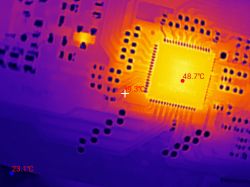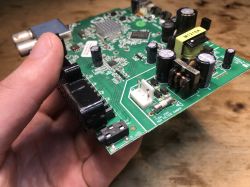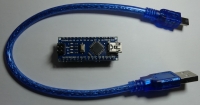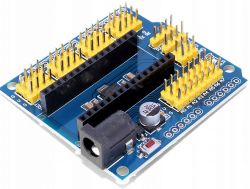The Arduino nano module equipped with a microcontroller will soon appear on elektroda.pl ATMega328P clocked with a 16MHz quartz resonator, power supply with 5V from the USB port. The board is equipped with a USB UART converter, which facilitates placing the program from the Arduino environment. On the board, there are LEDs informing about the presence of power, activity on the RX / TX lines of the UART interface and the LED connected to the D13 pin. The microcontroller is powered by 5V and the board ports operate at such logic levels, it should be remembered that some modules tolerate only 0-3.3V on the interfaces. The Arduino nano board also has a 5V stabilizer (power input> 5V on the VIN pin), there is also a reset button. Connector AND SP allows you to place the program using the programmer, using ISP, you can even opt out of the bootloader or the Arduino environment and send the compiled code written in, for example, Atmel Studio 7.0. Through the ISP connector we can change the microcontroller settings (fusebits). USB UART converter is CH340 and if there is no driver in the system, they are available on the manufacturer's website:
information about CH340
documentation
Windows drivers
Linux drivers
If the driver is installed correctly, a new serial COM port will appear in the system after connecting the module.
We start the integration with the board by downloading the Arduino environment, the current version is 1.8.4
We create a new program (sketch) and select the Arduino nano board:
Tools-> Board-> Arduino nano
Next:
Tools-> Port-> and select the COM port on which is the board connected to the USB.
As an example, we will move from the banal LED flashing to controlling the LED to the rhythm of the music.
LED flashing.
To check if everything is working properly, we will run the program which will flash the LED on the board (D13) and the LED connected with the anode to the D2 terminal, the LED cathode through the 220R resistor to ground (GND) on the contact plate. The LED state can be changed with digitalWrite (pin_number, LOW / HIGH)
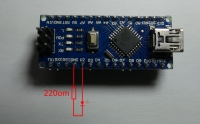
We compile and upload the program:
As a result, we have flashing LEDs and the flashing speed can be changed by modifying the delay value:
delay (1000);
[movie: 88fd792b6d] https://filmy.elektroda.pl/18_1505668055.mp4 [/ movie: 88fd792b6d]
Flashing LED with a change in brightness.
To change the brightness of the LED while flashing, we can use PWM with analogWrite (pin_number, value 0-255).
We connect the LED to D3 and through the 220R resistor to ground, compile and upload a simple program:
As a result, we obtain smooth changes in the brightness of the LED light.
[movie: 88fd792b6d] https://filmy.elektroda.pl/16_1505668363.mp4 [/ movie: 88fd792b6d]
Flashing RGB LED.
Connect the LED GRB cathode to D3, D5, D6 through 220R resistors, and the common anode to + 5V and with PWM we can smoothly mix the light colors. As the LED is connected with the anode to + 5V, the PWM 255 filling will mean the LED will go out.
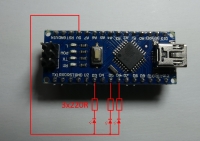
[movie: 88fd792b6d] https://filmy.elektroda.pl/5_1505668880.mp4 [/ movie: 88fd792b6d]
LED line that reacts to sound.
This time, we will connect the LEDs through resistors to GND to the D2, D3, D4, D5, D6, D7, D8, D9 pins and simulate the operation of the LED line responding to the signal given to the A0 input. We will use sample music to test the program: Link
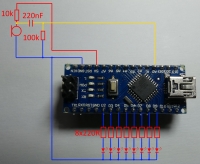
[movie: 88fd792b6d] https://filmy.elektroda.pl/53_1505669237.mp4 [/ movie: 88fd792b6d]
The miniature Arduino nano module can be useful for many experimental and prototype systems, while numerous examples and libraries will facilitate the implementation of your ideas. Here are two examples of using Arduino to record data on an SD card and in the built-in EEPROM memory:
Weekly measurement of mains voltage frequency - experiment.
Heart rate recording while sleeping - Arduino nano.
I encourage you to experiment with sample program codes, it can be quite an interesting tool in sound visualization FFT especially on the ESP8266 or ESP32 platform supporting Arduino and equipped with a faster processor and more RAM, it is worth taking a look at: FFT in practice using ESP32 and Arduino. Modules with ESP8266 have already appeared in the elektroda.pl gadgets, it is worth checking if they may have appeared again.
What is your idea of using Arduino nano?
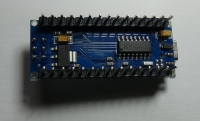
information about CH340
documentation
Windows drivers
Linux drivers
If the driver is installed correctly, a new serial COM port will appear in the system after connecting the module.
We start the integration with the board by downloading the Arduino environment, the current version is 1.8.4
We create a new program (sketch) and select the Arduino nano board:
Tools-> Board-> Arduino nano
Next:
Tools-> Port-> and select the COM port on which is the board connected to the USB.
As an example, we will move from the banal LED flashing to controlling the LED to the rhythm of the music.
LED flashing.
To check if everything is working properly, we will run the program which will flash the LED on the board (D13) and the LED connected with the anode to the D2 terminal, the LED cathode through the 220R resistor to ground (GND) on the contact plate. The LED state can be changed with digitalWrite (pin_number, LOW / HIGH)

We compile and upload the program:
Code: C / C++
As a result, we have flashing LEDs and the flashing speed can be changed by modifying the delay value:
delay (1000);
[movie: 88fd792b6d] https://filmy.elektroda.pl/18_1505668055.mp4 [/ movie: 88fd792b6d]
Flashing LED with a change in brightness.
To change the brightness of the LED while flashing, we can use PWM with analogWrite (pin_number, value 0-255).
We connect the LED to D3 and through the 220R resistor to ground, compile and upload a simple program:
Code: C / C++
As a result, we obtain smooth changes in the brightness of the LED light.
[movie: 88fd792b6d] https://filmy.elektroda.pl/16_1505668363.mp4 [/ movie: 88fd792b6d]
Flashing RGB LED.
Connect the LED GRB cathode to D3, D5, D6 through 220R resistors, and the common anode to + 5V and with PWM we can smoothly mix the light colors. As the LED is connected with the anode to + 5V, the PWM 255 filling will mean the LED will go out.

Code: C / C++
[movie: 88fd792b6d] https://filmy.elektroda.pl/5_1505668880.mp4 [/ movie: 88fd792b6d]
LED line that reacts to sound.
This time, we will connect the LEDs through resistors to GND to the D2, D3, D4, D5, D6, D7, D8, D9 pins and simulate the operation of the LED line responding to the signal given to the A0 input. We will use sample music to test the program: Link

Code: C / C++
[movie: 88fd792b6d] https://filmy.elektroda.pl/53_1505669237.mp4 [/ movie: 88fd792b6d]
The miniature Arduino nano module can be useful for many experimental and prototype systems, while numerous examples and libraries will facilitate the implementation of your ideas. Here are two examples of using Arduino to record data on an SD card and in the built-in EEPROM memory:
Weekly measurement of mains voltage frequency - experiment.
Heart rate recording while sleeping - Arduino nano.
I encourage you to experiment with sample program codes, it can be quite an interesting tool in sound visualization FFT especially on the ESP8266 or ESP32 platform supporting Arduino and equipped with a faster processor and more RAM, it is worth taking a look at: FFT in practice using ESP32 and Arduino. Modules with ESP8266 have already appeared in the elektroda.pl gadgets, it is worth checking if they may have appeared again.
What is your idea of using Arduino nano?

Cool? Ranking DIY



